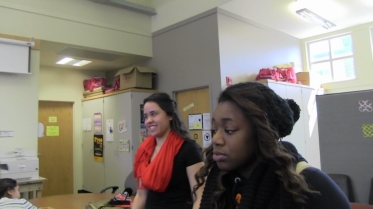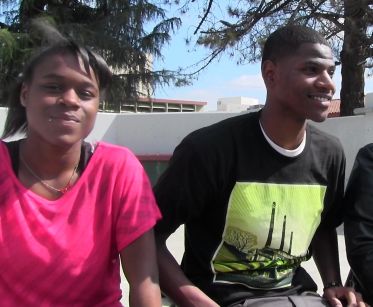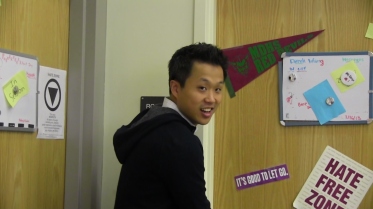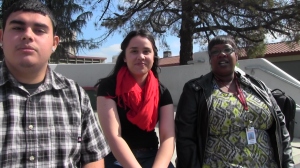In May 2011, Mt. Diablo High School in Concord, CA, hired social worker Deonne Wesley to coordinate a grant from the U.S. Department of Education Safe and Supportive Schools program. The program was set up to “create and support safe and drug-free learning environments and to increase academic success for students in these high-risk schools”.
It took a year for California to lay the foundation for the program, and another year for each of the 58 participating school districts to hire staff. At Mt. Diablo, which has 1,340 students, the program was up and running during the 2012-2013 school year.
Wesley trained 18 students to be peer mediators to work with students who were suspended for fighting, and to help prevent fights.
Those mediators worked with 46 students who had racked up 51 days of suspension for fighting in school. The peer mediators, with Wesley supervising, helped the students talk out the dispute and come to an agreement on how to avoid further conflict. Afterwards, the number of suspensions for those 46 students dropped to 19 for the rest of the school year.
The grant also funded a part-time drug and alcohol counselor. She led four eight-week workshops and two ongoing harm-reduction groups. Prior to attending the workshops, 80 students who attended at least two workshops had accumulated 242 days of suspensions. After they attended the workshops, the suspensions in that group dropped to six.
During this 2013-2014 school year, 23 peer mediators have already served 36 students. To meet demand, the drug counselor’s hours were increased from 12 to 16 hours a week. (Most students suspended for drugs use alcohol and marijuana.) She’s started two workshops, and plans on launching several harm reduction groups.
The good news: The program is teaching kids how to change their behavior so that they stop fighting. The peer mediators are becoming leaders. Some teachers are resolving conflicts with their students, which results in more teaching and more learning.
The bad news: The grant runs out in 2014, at the end of this school year. Next school year, Mt. Diablo won’t have peer mediators or a drug counselor.
“We’re trying to look at ways to sustain the programs,” says Wesley. “But you know how that goes.”
_____________________
On a bright and surprisingly warm day in January 2013, Shianne Wynne, a confident and energetic senior from Concord, sits in Wesley’s small office. She’s been invited, with a few other students, to talk about how she does peer mediation. “We deal with a lot of ‘he-say-she-say’, which leads to kids fighting,” she explains. “Once, a girl wanted to fight another because she said the girl had called her fat. I asked her: ‘Is it really worth fighting and going to jail? Is it really worth having a record at age 16?’ It turns out the girl didn’t call her fat to her face. She’d heard that the girl called her fat.”
Peer mediators Kristen Burns (l) and Cheyna Reed (r). (All photos in this article were taken by the peer mediators.)
Wynne used the skills she’d been taught during two days of training: how to handle different scenarios and how to be aware of people’s feelings. She helped the girls get over their immediate anger. By the time they had a formal meeting with Wesley and Wynne, they weren’t mad. “The conversation lasted seven minutes,” says Wynne.
At Mt. Diablo High School, if students fight, they’re automatically suspended. They’re also suspended for possession of drugs or alcohol. And a teacher can suspend them from their classroom for willful defiance, as well as a host of other reasons. Suspensions last one to five days, depending on whether the students have been suspended previously and the severity of the fight.
Mt. Diablo has a suspension rate that’s twice the rate of the Mt. Diablo Unified School District, and a truancy rate that’s three times that of the district.
Since Wesley established the conflict resolution program, the students are required to participate in a mediation session with their teacher or the student they fought with. If they are suspended for drugs, they are required to participate in a drug-prevention workshop.
Wesley recruited Dajon (Broddy) Mathis, an outgoing senior from Pittsburg, CA, to become a peer mediator when Wesley watched him work out a conflict with another student. “I was really impressed at how he handled the situation,” she says. “He did it all himself. He told the other young man: ‘Whatever is said in here, stays in here. We can handle it.’ And they did.”
“I’ve mediated twice,” says Mathis. “The first time, I was a little nervous. But it’s like a game: Once you start doing it, it’s easy. Now I break up fights all the time. When I was younger, I used to egg-on fights. Now that I’m older, I’m more mature. It’s not cool. Now I have a secret weapon – my mediation skills. Sometimes, they don’t even know I’m using them.”
Peer mediator Ashley Holmes is a sophomore at Mt. Diablo High School. Peer mediator Dajon (Broddy) Mathis graduated in June 2013.
___________________________
“We get them to talk it out,” says Ashley Holmes, a remarkably mature freshman from Oakland. “We tell them there’s no need for physical fighting, that they probably don’t even have to fight about this situation, because it’s not that big a situation. Without everyone egging them on, they wouldn’t even be interested in fighting.”
But, she acknowledges, there are some people who don’t care. “You tell them, but they don’t listen.”
“Yeah,” says Mathis. “They come in with a closed mind – closed off to the point that we can’t help them. I don’t know what it is.”
“It’s because they have trust issues,” says Holmes.
____________________
At the start of the current 2013-2014 school year, Wesley trained 18 more peer mediators. With the five who remain from last year, this group of 23 has taken their work a step further, she says.
“I’ve seen them step in and stop things from getting ugly,” she says. “They also figure out who the kids are who are on the edge and refer them to me for mediation. A couple of them heard that freshman girls were engaging in dangerous sexual activity, and recommended that someone from the health clinic come in and talk with them. That shows they’re also taking a leadership role in determining what their school needs and how can they fill in those spots.”
Beginning in January, the mediators will do a series of presentations for freshman about nonviolence and conflict resolution. They’re also part of a mentoring program that matches upperclassmen with freshmen.
Wesley says that it took a while for teachers to take advantage of the mediation program. One who did is history 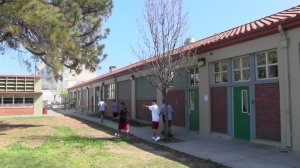 teacher Lori Johnson, who was having issues with a teen who disrupted her class. She knew he was smart and other kids followed his lead, but he wouldn’t do what she asked. “He doesn’t have access to his parents, so calling them wasn’t an option, and that was part of the problem,” she explains. “The continued frustration on my part and the class disruptions would have resulted in suspending him. It was driving me nuts.”
teacher Lori Johnson, who was having issues with a teen who disrupted her class. She knew he was smart and other kids followed his lead, but he wouldn’t do what she asked. “He doesn’t have access to his parents, so calling them wasn’t an option, and that was part of the problem,” she explains. “The continued frustration on my part and the class disruptions would have resulted in suspending him. It was driving me nuts.”
Johnson took advantage of Wesley’s offer. During the mediation, the history teacher was able to tell the teen how much she wanted him to be a positive role model, and how she believed that he could take a leadership role.
“He said he’d wanted to help, but didn’t know how, and so he screwed around instead,” says Johnson. The teen needed a caring adult to believe in him, to tell him so and to guide him. Wesley asked her what specifically the student could do. Johnson now has him help other students in the class.
“He has turned from being a bothersome student to someone who makes the class better,” she explains. “He sometimes needs a reminder, but he listens. This kid is super duper bright.”
Johnson has changed her behavior, too. She doesn’t scold him. She encourages him and praises him. “He hangs out after class, waiting for that praise,” she says. When asked if she thinks she might be the only adult in his life who’s providing that encouragement, she nods thoughtfully and says: “Probably.”
Although most teachers are on board with the program, says Wesley, nobody takes it seriously. “One of the things I heard constantly is, this too shall pass,” she says. Other programs, including curriculum changes, have come and gone. The teachers ask her: Why should I invest time and energy in this when it’s going to go away?
The one consistent bright spot for helping troubled students is the school’s Diablo Community Center, which was established with a California Healthy Start grant in 2003, says Derek Wang, the social work specialist who directs the center.
___________________________
“We try to make the center a one-stop shop – we provide them services or refer them,” he says.
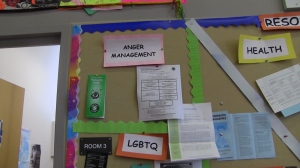 About 400 teens– nearly one-third of the student body — make use of the center’s services each year. The center provides individual and group counseling. Groups include grief and loss, anger management, gender issues, attendance and LGBTQ groups. There are groups for Latino males, African-American females and males, and Asians. Activities include folklorico dance, running, meditation, yoga and crocheting. Students can obtain health services from the Contra Costa County health clinic, which sends staff twice a week. The center provides referrals for family counseling.
About 400 teens– nearly one-third of the student body — make use of the center’s services each year. The center provides individual and group counseling. Groups include grief and loss, anger management, gender issues, attendance and LGBTQ groups. There are groups for Latino males, African-American females and males, and Asians. Activities include folklorico dance, running, meditation, yoga and crocheting. Students can obtain health services from the Contra Costa County health clinic, which sends staff twice a week. The center provides referrals for family counseling.
“All of our counseling here focuses on a strength-based approach,” says Wang. “A lot of resiliency research shows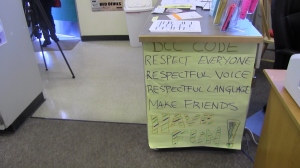 that students who develop positive relationships at school build abilities to cope. They receive group support, so that they see they’re not the only ones facing the same stressors.”
that students who develop positive relationships at school build abilities to cope. They receive group support, so that they see they’re not the only ones facing the same stressors.”
________________________
Wesley, who has a 21-year-old son, recalls an incident that occurred during his first year of middle school. He fought with another student and was suspended. “I went in and talked with the school staff about the suspension policy,” she says. “I suggested that we make this a teachable moment, and make the kids participate in a community building project instead of suspension. I remember them looking at me like I was some alien from outer space.
“Suspensions don’t work,” she continues. “Kids who are suspended go home and play video games. My biggest issue is suspending kids for drug and alcohol. Keeping them out of school for three to five days just gives them more time to get high.”
The research is very clear that California’s zero-tolerance policies have led to more students being suspended every year than graduate. The policies have also led to kids dropping out of school and feed the school-to-prison pipeline.
When kids are suspended, nobody’s teaching them to how to repair or resolve conflicts with students or teachers, she says. “What are we teaching them when we send them home?”
Wesley would like to see the district make several changes: stop suspensions and expulsions for “willful defiance”, because “defiance” is so objective; revamp the curriculum so that subjects are taught in a culturally relevant way; and train teachers in the effects of adverse childhood experiences on children’s developing brains, and how to implement trauma-informed practices.
“Teachers need to understand what students are presenting to them in class,” says Wesley. “Teachers trained that way see beyond the behavior to the underlying reason. They know that punishment is not the answer.”
Peer mediators Mike Guillen (l) and Kristen Burns (m) with Deonne Wesley (r), the Mt. Diablo High School social worker who coordinates the Safe and Supportive Schools program.
_______________________
As a result of some serious nudging from the state, the district has just started taking steps in that direction. In 2012, the California Department of Education identified Mt. Diablo School District as one that was “significantly disproportionate in the over-identification of African-American students as emotionally disturbed”.
In other words, kids who were causing the most trouble were labeled “emotionally disturbed”, shunted out of regular classrooms and into special education, a common practice across the country. The district decided to revamp its approach so that all students receive the “academic and behavioral supports to succeed.” The district plans on integrating a PBIS framework in all schools, developing alternatives to suspensions, and providing training for all staff. Six pilot schools were chosen to participate this school year.
Tens of thousands of schools across the country have already implemented programs such as PBIS, Safe and Civil Schools, and restorative practices. Many are transitioning to becoming trauma-informed schools, and have stopped suspending and expelling students.
“I’m excited that it’s happening and that people get it,” says Wesley. “And I’m glad that the district is starting to address these issues. It’s so urgent that we do so.”
___________________
This is part of an investigative series into “right doing” – how some schools, mostly in California, are moving from a punitive to a supportive, compassionate approach to school discipline. The series includes profiles of schools in Le Grand, Reedley, Fresno, San Francisco, Los Angeles, Vallejo, and San Diego, CA; and Spokane, WA, and Brockton, MA. The series is funded by the California Endowment.
Suspensions plummet with peer mediation, but at this school, it’s just another program that’s going away was originally published @ ACEs Too High » Jane Ellen Stevens and has been syndicated with permission.
Sources:
Our authors want to hear from you! Click to leave a comment
Related Posts






